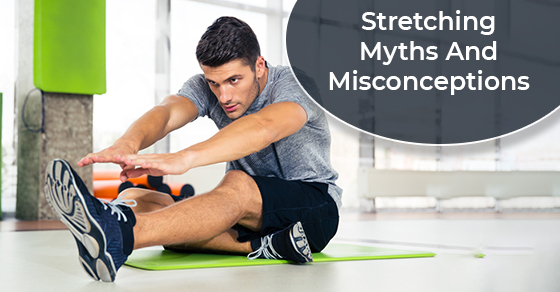Osteoarthritis Treatments: What You Need to Know...
Key Highlights: Osteoarthritis treatments focus on pain relief, restoring joint…
Read More
Posted by Dr. Scott Wilson | 10-Sep-2018
One of the most common pieces of advice we hear from those who workout often, is the importance of stretching — but should you believe everything you hear? While it’s important to follow proper stretching guidelines when engaging in a physical workout, there are some common misconceptions out there. Keep on reading to find out some of the myths about stretching.
Before you even begin stretching, you need to make sure that your muscles are properly warmed. If you do intense stretches while your muscles are still cold, you could end up pulling a muscle. Before engaging in so-called “static” stretching — stretching done while the body is at rest — warm up by running in place or doing some jumping jacks.
Engaging in dynamic stretches after your workout can be quite beneficial, and can help your muscles relax after intense activity.
By increasing blood flow to muscles and improving range of motion, stretching decreases the likelihood of certain types of injuries — but that doesn’t it can prevent them completely. You can still pull a muscle or twist your ankle, even when you stretch beforehand. Moreover, faulty techniques, improper use of equipment, and just plain overdoing it can lead to injuries, regardless of whether you stretched first or not.
This completely contradicts myth #2, but there are some people out there that blame stretching for injuries they’ve incurred. The truth is, poor technique and instruction have more to do with causing injury than the act of stretching itself. When done properly, stretching can play an important role in the warm-up process in order to achieve better function and performance.
If your muscles are sore, intense stretching will not only be of no benefit to you, but it can make your muscles feel even worse by furthering the tiny tears in your muscle fibres. When you’ve just finished a vigorous workout it’s best to go easy on the stretching afterwards; the more intense and strenuous the workout, the more careful you need to be about post-workout stretching.
Stretching routines vary – it depends on many factors including age, your typical workout routine, and even your gender. Static stretching is usually better for improving your flexibility for doing exercises like dance or gymnastics, while dynamic stretching is better for those engaging exercise that involves running or jumping.
Just like with anything, there is such a thing as too much stretching. It’s possible to overstretch and give yourself an injury or aggravate an existing one if your muscles are already tight and sore. Be sure to start off easy, and try not to overdo it if you’ve been feeling the strain.
The effects of foam rolling — also called myofascial release — are more akin to those of a deep tissue massage that breaks down the scar tissue in your body, while stretching focuses on improving flexibility.
When Shouldn’t You Stretch?
While there are many benefits of stretching, there are times when stretching is unequivocally something that you should not do. For example, if you have had a recent injury (i.e., one that has occurred within the past few days) you’re probably better off resting and not risk making the injury worse.
Other situations where stretching is not advised include:
Post-Surgery
If you’ve recently gone under the knife — especially if it was surgery involving your Achilles tendon or hamstrings — you should avoid stretching until cleared to do so by your doctor or physiotherapist; you’ll want to make sure that your muscle tissue has healed sufficiently before putting it under any stress.
You’re Heading Out to the Playing Field
If you’re about to engage in a game of basketball, soccer, hockey or any other sport that involves a lot of stops, starts and abrupt uses of muscle force, then static stretching — slowly extending a muscle to its end range of motion — isn’t a good idea, since it can increase your risk of injury.
Muscle Knots/Spasms
Spasms are involuntary muscle contractions, and trying to stretch them out will only increase the pain. In these types of situations, opt for a massage instead.
The Benefits of Stretching
To get the full benefits of stretching, these some basic, easy to follow guidelines:
Before you begin a workout, it’s best to start with dynamic stretching. This is especially true before engaging in intense workouts that require fast movements and flexibility. The main advantage of dynamic stretching is that it gently works your muscles up to their full range of motion, instead of holding a maximum stretch for a long period of time. Squats, lunges, high knees, side kicks, skipping, and arm circles are all examples of dynamic stretching exercises. For the best results, stretch until you feel a slight pull; stretches should never cause you to feel pain.
After your workout is done, try some static stretches. If your muscles are tight, static stretches like hamstring stretches, quad stretches, and arm and shoulder stretches can help with releasing some of that tension.
Remember; improved flexibility involves a combination of mobilization, stretching and strengthening. While just stretching by itself is beneficial, combining all three will yield much better results.
For more information about how to keep your muscles healthy and strong, contact Physiomed today.

Key Highlights: Osteoarthritis treatments focus on pain relief, restoring joint…
Read More
Key Highlights: Runner's knee, or patellofemoral pain syndrome, is a…
Read More
Key Highlights: Upper back and neck pain can be caused…
Read More
Key Highlights: Many people want to lose belly fat for…
Read More
Key Highlights: Vestibular physical therapy, or physiotherapy, is a specialized…
Read More
Key Highlights: Tennis elbow, or lateral epicondylitis, is a condition…
Read More